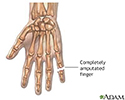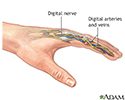Replantation of digits
Revascularization of amputated digits; Reattachment of amputated fingers
Replantation of digits is surgery to reattach fingers or toes that have been cut off (amputated).
Description
Surgery is done the following way:
-
General anesthesia
will be given. This means the person will be asleep and unable to feel pain. Or regional anesthesia (
spinal and epidural
) will be given to numb the arm or leg.
General anesthesia
General anesthesia is treatment with certain medicines that puts you into a deep sleep so you do not feel pain during surgery. After you receive the...
Read Article Now Book Mark ArticleSpinal and epidural
Spinal and epidural anesthesia are medicines that numb parts of your body to block pain. They are given through shots in or around the spine....
Read Article Now Book Mark Article - The surgeon removes damaged tissue.
- The ends of the bones are trimmed.
- The surgeon places the finger or toe (called the digit) in place. The bones are rejoined with wires or a plate and screws.
- Tendons are repaired, followed by nerves and blood vessels. Nerve and blood vessel repair is the most important step to the success of the procedure. If needed, tissue with nerves and blood vessels from another part of the body is used.
- The wound is closed with stitches and bandaged.
Why the Procedure Is Performed
The surgery is done when fingers or toes have been amputated, and are in a condition that would allow replantation.
Risks
Risks for anesthesia and surgery in general include:
- Reactions to medicines, breathing problems
- Bleeding, blood clots, infection
Risks of this surgery include:
- Death of the replanted tissue
- Decreased nerve function or movement in the replanted digit
- Stiffness of the digits
- Pain that continues after surgery
After the Procedure
Special care will be taken while you are in the hospital to make sure blood flows properly to the reattached part. The arm or leg will be kept raised. The room may be kept warm to ensure proper blood flow. The reattached part will be checked often to make sure there is good blood flow.
After you are released from the hospital, you may need to wear a cast to protect the finger or toe. The surgeon may prescribe blood-thinning medicines to prevent blood clots.
Proper care of the amputated part or parts is very important to successful replantation. Under the right conditions, there is a good chance that the surgery can restore the use of the finger or toe. You will need follow-up visits with your health care provider, who will continue checking blood flow in the surgery area.
Outlook (Prognosis)
Children are better candidates for replantation surgery because of their greater ability to heal and regrow tissue.
Replantation of an amputated part is best done within 6 hours after the injury. But replantation can still be successful if the amputated part has been cooled for up to 24 hours after the injury.
You will not have the same flexibility in the finger or toe after surgery. Pain and sensation changes may continue.
References
Higgins JP. Replantation. In: Wolfe SW, Hotchkiss RN, Pederson WC, Kozin SH, Cohen MS, eds. Green's Operative Hand Surgery . 7th ed. Philadelphia, PA: Elsevier; 2017:chap 42.
Klausmeyer MA, Jupiter JB. Replantation. In: Browner BD, Jupiter JB, Krettek C, Anderson PA, eds. Skeletal Trauma: Basic Science, Management, and Reconstruction . 5th ed. Philadelphia, PA: Elsevier Saunders; 2015:chap 51.
Moore D. Management of amputations. In: Roberts JR, ed. Roberts and Hedges' Clinical Procedures in Emergency Medicine . 6th ed. Philadelphia, PA: Elsevier Saunders; 2014:chap 47.
-
Amputated finger - illustration
Replantation of an amputated part is ideally performed within 4 to 6 hours after injury, but success has been reported up to 24 hours after the injury if the amputated part has been cooled. During surgery, bone, tendon, ligaments, nerves, and vessels are reattached. Success depends upon if the blood supply can fully be restored to the amputated portion and if the nerves reattach successfully. Proper care of the amputated part is vital to successful replantation. Under proper conditions, the long-term prognosis for the restoration of function in an amputated part is quite good.
Amputated finger
illustration
-
Replantation of digits - series
Presentation
-
Amputated finger - illustration
Replantation of an amputated part is ideally performed within 4 to 6 hours after injury, but success has been reported up to 24 hours after the injury if the amputated part has been cooled. During surgery, bone, tendon, ligaments, nerves, and vessels are reattached. Success depends upon if the blood supply can fully be restored to the amputated portion and if the nerves reattach successfully. Proper care of the amputated part is vital to successful replantation. Under proper conditions, the long-term prognosis for the restoration of function in an amputated part is quite good.
Amputated finger
illustration
-
Replantation of digits - series
Presentation
Review Date: 9/22/2016
Reviewed By: C. Benjamin Ma, MD, Professor, Chief, Sports Medicine and Shoulder Service, UCSF Department of Orthopaedic Surgery, San Francisco, CA. Also reviewed by David Zieve, MD, MHA, Isla Ogilvie, PhD, and the A.D.A.M. Editorial team.







